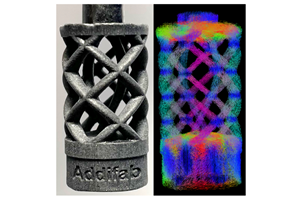SPE ACCE picks best paper award winners
Three authors will be honored for excellence in technical writing with a commemorative plaque during SPE ACCE opening ceremonies on September 7.
The organizing committee for the SPE Automotive Composites Conference & Exhibition (ACCE) announced the Dr. Jackie Rehkopf Best Paper Award winners for the group’s 16th-annual show, Sept. 7-9, 2016 at the The Diamond Banquet & Conference Center at the Suburban Collection Showplace, Novi, MI. Three authors who received the highest average ratings by conference peer reviewers out of a field of 92 contenders will be honored for excellence in technical writing with a commemorative plaque during SPE ACCE opening ceremonies on September 7.
Sebastian Goris, a doctoral student at the University of Wisconsin-Madison and graduate research assistant at the Polymer Engineering Center took first place in this year's competition; Dr. Ying Fan, a research engineer in the Department of Mechanical and Materials Engineering at Western University took second place; and Christoph Kuhn, who is simultaneously working as a project engineer in the Group Research department at Volkswagen AG and also pursuing a doctorate degree at Friedrich-Alexander University Erlangen-Nuremberg, placed third in the competition. The conference's best paper awards honor long-time SPE ACCE committee member, session organizer, two-times technical program co-chair, and long-time automotive-composites industry researcher, Dr. Jackie Rehkopf.
Goris was lead author along with his advisor, professor Tim Osswald of the Polymer Engineering Center (PEC) at University of Wisconsin-Madison on a paper entitled Progress on the Characterization of the Process-Induced Fiber Microstructure of Long Glass Fiber-Reinforced Thermoplastics. The paper will be presented on September 8 from 11:00-11:30 a.m. in the Virtual Prototyping & Testing - Part 4 session at the conference. About his topic, the author says, "The work described in this paper discusses new measurement approaches that we've developed at the PEC to determine the full three-dimensional fiber architecture obtained using micro computed-tomography technology for fiber orientation and fiber density distribution as well as an automated process to determine the fiber-length distribution. Results of the work measured on 40-wt% injection molded long [glass] fiber-[reinforced] thermoplastic polypropylene [LFT-PP] suggest that the common assumption of uniform fiber length and fiber density distribution in injection molded parts is not correct. The potential impact of the heterogeneity of process-induced microstructure that we found can be critical for accurate analysis of LFT parts and should inform future material modeling approaches."
Fan was lead author on a paper entitled Effects of Processing Parameters on the Thermal & Mechanical Properties of LFT-D-ECM Glass Fiber/Polyamide 6 Composites. Her co-authors were Y.C Liu, T. Whitfield, T. Kuboki and J.T. Wood from Western University (WU) as well as V. Ugresic from the Fraunhofer Project Centre for Composites Research. The paper will be presented on September 7 from 2:30-3:00 p.m. in the Advances in Thermoplastic Composites - Part 3 session. About her topic, Fan explains "We investigated the influences of process parameters ― including melt temperature, extruder fill level, glass fiber temperature, and screw speed in the mixing extruder ― on the thermal and mechanical properties of direct/inline compounded 30- wt% long [glass] fiber-reinforced thermoplastic [D-LFT] polyamide 6 [PA 6, also called nylon 6], which was subsequently compression molded. The effects of processing parameters on glass transition temperature [Tg], melt temperature [Tm], and relative degree of crystallinity will be presented in this work."
Kuhn was lead author along with William Kucinski and Olaf Taeger at Volkswagen Group Research and Prof. Tim Osswald at University of Wisconsin-Madison on a paper entitled Lightweight Design with Long Fiber Reinforced Polymers ― Technological Challenges due to the Effect of Fiber Matrix Separation. The paper will be presented on September 7 from 1:30-2:00 p.m. in the Advances in Thermoplastic Composites - Part 3 session. About his research, Kuhn comments, "A major effect that results when processing long fiber-reinforced thermoplastics [LFT] is fiber matrix separation [FMS], which leads to a non-uniform fiber density distribution throughout the part. Experimental investigations in compression molding with LFT composites have shown an unequal distribution of fiber content in free-flow regions and especially in complex geometries. In the case of rib sections, for example, fiber content decreases greatly, leading to a significant change in component behavior. Through experimentation, our team analyzed the governing mechanism of FMS and developed a new approach for predicting the phenomenon."
Related Content
Seat frame demonstrates next-generation autocomposites design
Light weight, simplified/cost-effective manufacturing, passenger comfort and safety informed materials and process innovations and won awards for the 2022 Toyota Tundra‘s second-row seat frame.
Read MoreCo-molding SMC with braided glass fiber demonstrates truck bed potential
Prepreg co-molding compound by IDI Composites International and A&P Technology enables new geometries and levels of strength and resiliency for automotive, mobility.
Read MoreXnovo Technology, Exciscope introduce X-ray tensor tomography technique
Through a strategic partnership, the companies introduce the FiberScanner3D module, dedicated to bringing more rapid, reliable and robust fiber structure characterization methods to lab settings.
Read MoreTU Munich develops cuboidal conformable tanks using carbon fiber composites for increased hydrogen storage
Flat tank enabling standard platform for BEV and FCEV uses thermoplastic and thermoset composites, overwrapped skeleton design in pursuit of 25% more H2 storage.
Read MoreRead Next
VIDEO: High-volume processing for fiberglass components
Cannon Ergos, a company specializing in high-ton presses and equipment for composites fabrication and plastics processing, displayed automotive and industrial components at CAMX 2024.
Read MoreDeveloping bonded composite repair for ships, offshore units
Bureau Veritas and industry partners issue guidelines and pave the way for certification via StrengthBond Offshore project.
Read MorePlant tour: Daher Shap’in TechCenter and composites production plant, Saint-Aignan-de-Grandlieu, France
Co-located R&D and production advance OOA thermosets, thermoplastics, welding, recycling and digital technologies for faster processing and certification of lighter, more sustainable composites.
Read More
















.jpg;maxWidth=300;quality=90)








